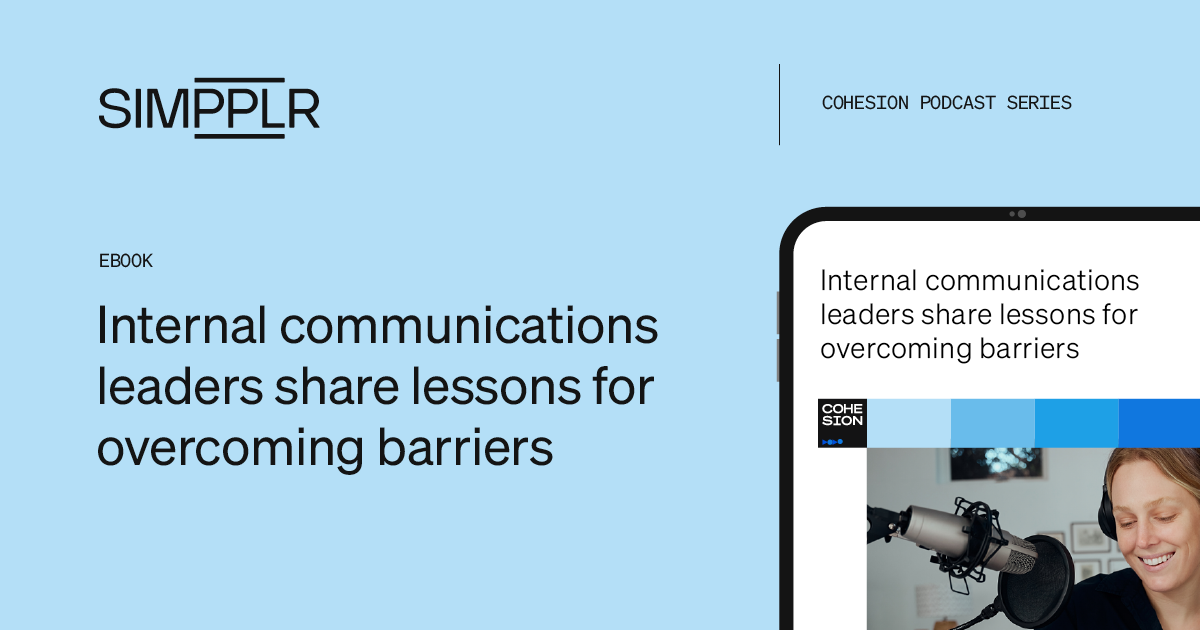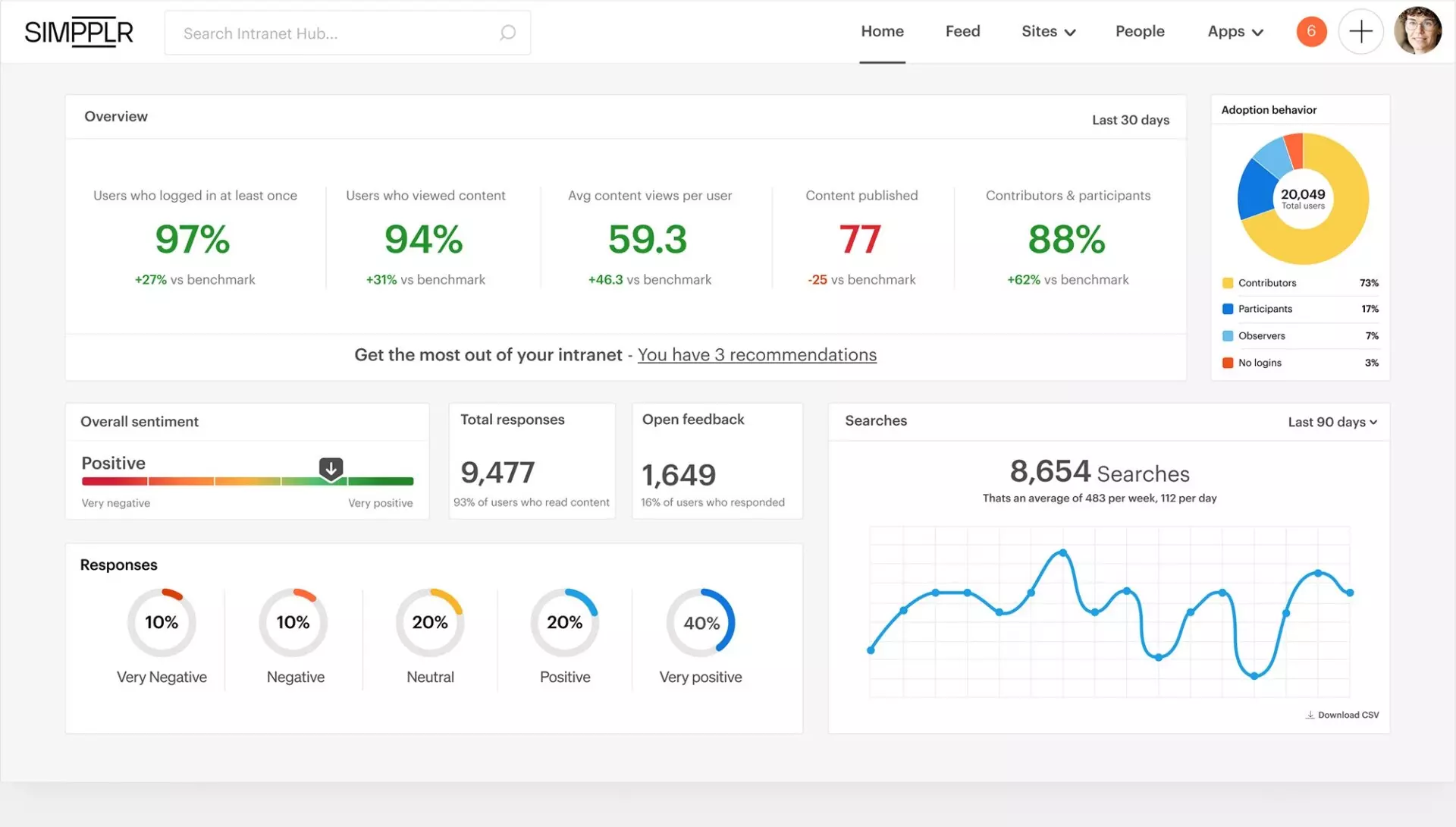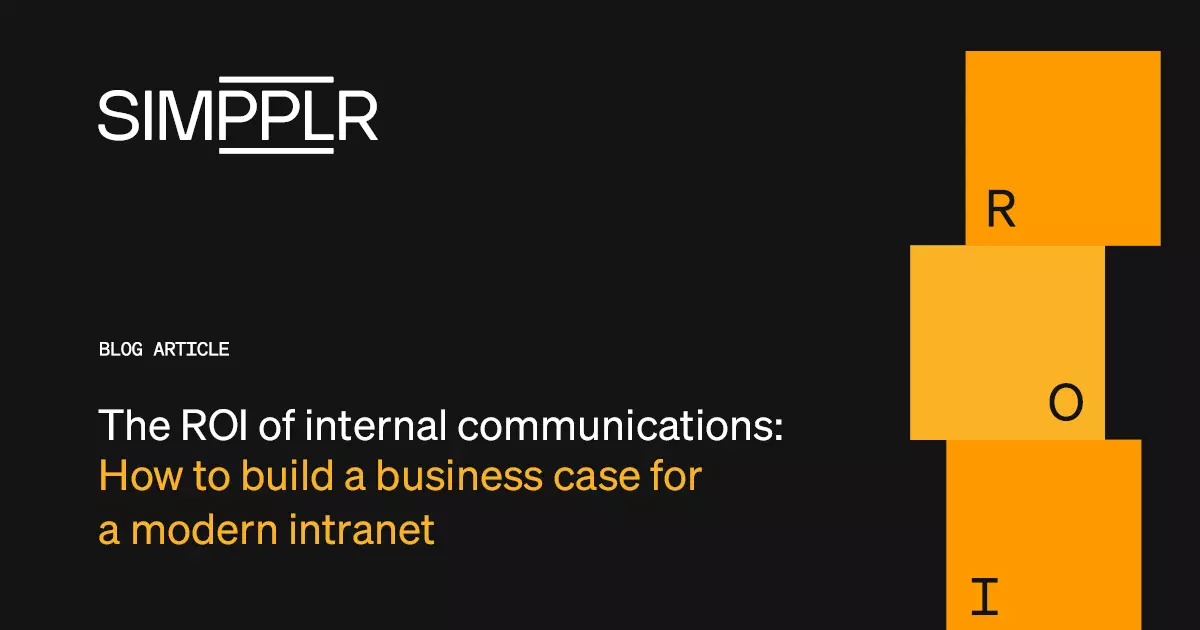Definition of internal communications
Internal communications is the function responsible for effective communications among participants within an organization. In simple terms, the definition of internal communications is to keep everyone in the organization informed. And while the purpose is pretty straightforward, the task can be challenging to do well!
- 1 What is internal communications?
- 2 Purpose of internal communications
- 3 Types of internal communications
- 4 Why is internal communications important?
- 5 Challenges IC teams face
- 6 Best practices for internal communications teams
- 7 How to improve internal communications
- 8 How to build an IC strategy
- 9 Understanding the ROI of Internal Communications
- 10 Tools to improve internal communications
What is internal communications?
Internal communication is essential to ensure clarity for everyone within an organization. But what does effective internal communication look like, and how can you cultivate successful and effective internal communications within your organization?
Below we will discuss the definition of internal communications, explore why it’s so essential and tackle a few of its challenges. We’ll also reveal ways to overcome these challenges with a solid communications strategy, including some of the best practices and tools required for a stellar internal communication offering.
Purpose of internal communications
Internal communication shares information that supports employees in doing their job. It keeps everyone on the same page and updated on the organization’s happenings.
Internal communication’s purpose is to provide a solid stream of information between leadership, departments, and employees. This includes communications up and down the management/employee chain and between work colleagues.
Solid internal communications should support a cohesive work culture and boost employee engagement.

Types of internal communications
With much of our modern workforce working remotely or hybrid, it’s more important than ever to invest in effective internal communications.
Information sharing can be done through various channels, including verbal, on paper, or electronically such as the company intranet. The tremendous advantage of an intranet is that it’s available 24/7, and everyone in the organization can access it from any location with an internet connection and a mobile device. The top five types of internal communications are:
- Management – dispenses information such as strategies, company results, proprietary information, competitive intelligence, and other important general information.
- Team – colleagues who work together share insight to further efforts to achieve the same end goal.
- Face-to-face – individuals are briefed on tasks and situations during meetings and in passing when everyone is working in the same building.
- Peer – colleagues have informal chats to share information at actual or virtual water coolers.
- Resources – organizations rely on the intranet, email, social media, messaging, video calls, and telephones to share critical info that needs to reach everyone at once. The trick is creating a single source of truth for everyone to refer back to.
Discover our guide for the best intranet platforms for 2025
Why is internal communications important?
There are many benefits to having a robust, organized, and flexible internal communication function in an organization, including its ability to:
1. Boost employee engagement and productivity
Internal communications unite leaders and employees to focus on internal strategies that boost engagement and productivity. When employees are encouraged to submit their ideas and opinions to leadership, they feel valued and heard, which leads to engagement. When employees are engaged, they are more creative and productive.
2. Build trust within your organization
Another benefit of internal communication is that it delivers the right message to the right people. Employees expect and trust that the information they receive and know is essential and relevant to them; therefore, they pay attention. Effective internal communication ensures that employees don’t suffer from information overload. It respects their time by only sharing content that they need.
3. Improve employee experience
No one wants to feel left out. An exemplary internal communication capability ensures that important company information gets to everyone, as well as the fun stuff that builds community and connections. It’s a great way to share company events, challenges, and benefits that bring your work culture to life.
4. Share goals and objectives that drive actions
Keeping everyone on the same page and sharing the organization’s vision helps employees feel well-informed and confident when acting. In addition, a clear roadmap that promotes company strategy helps everyone understand where the organization is headed. This helps people make informed decisions and feel empowered to take the next step without creating bottlenecks as they await permission to perform necessary tasks.
5. Allow for quick responses
Technology is ever-evolving. Competition is fierce, and organizations must adapt quickly to succeed. Strong internal communication means that your team is in harmony, so when a crisis arises, everyone works together and is in sync on both process and response chains.
6. Offer location-independent engagement
Effective internal communication blurs borders and brings your team together. With most folks working remotely or hybrid these days, it’s vital to have solid internal communications that considers the global workforce, so everyone feels connected.
7. Promote the brand
Gartner Communications found that “employees who feel well-informed become a company’s most credible ambassadors externally, while they may become its fiercest critics if they do not.”
No one will promote your brand as well as a happy employee. And no one will criticize it like a disgruntled one.
Check out our blog to read more about the importance of internal communications.

Challenges IC teams face
1. Lack of employee engagement
Effective communication is almost impossible within organizations where people are not motivated and engaged.
2. Improper IC tools
We all know communication is a full-time task. However, ensuring all relevant information reaches everyone in a timely manner can cause challenges. Having the right tools for the job is critical when it comes to keeping your employees informed and engaged, and having app integrations helps with this process.
3. Information black holes
Information silos refer to instances where information becomes isolated and is not effectively shared within an organization. This can pose a significant challenge for directors of communications, particularly in large organizations. According to Cognitive University for Watson Systems SmartSeller, employees spend an average of 2.5 hours a day looking for information, and that’s just too much—they get lost in black holes. Efficient internal communication capabilities prevent this from happening.
4. Lack of feedback
Employee feedback is connected to employee engagement and satisfaction. If you’re not receiving feedback, it could be because your employees don’t feel safe to share or don’t care enough to let you know how they feel. Sending out employee experience surveys is a great way to encourage your team to speak up, especially when they’re anonymous.
5. No way to measure internal communications success
How do you know if what you are doing is working? Being able to measure your efforts shows you where you are succeeding and where you can improve. Internal communications without measurement is like a shot in the dark. You’ll never know if you are reaching your employees and hitting your mark.
6. Wrong communications technology
Having the right technology in place makes all the difference. Implementing modern employee engagement solutions is a crucial step for eliminating communication problems in the workplace. This is where IT and internal communications unite to find and implement the right tools for your organization—the challenge is finding common ground to get them to agree. The best practices that follow should help!

Best practices for internal communications teams
Let’s look at some of the best practices every HR leader needs to build a stellar internal communications system.
1. Ensure your messages reach every employee
This may go without saying, but it is critical that you reach everyone. When employees can use their smart devices to access company communications, it instantly breaks down location and technology barriers.
2. Have an internal communications strategy
This is the roadmap to your success. It should define your business goals and identify the activities you’ll need to implement.
3. Create a two-way channel for feedback
Allowing communication to flow up and down the org chart creates an environment where everyone feels heard and builds trust within your team and your organization. This also gives you a way to receive feedback to ensure your internal communication strategy is working.
4. Maintain a consistent stream of communication
A consistent stream of communication keeps everyone informed and sets expectations. When communications are consistent, employees are more engaged, and important information is less likely to be ignored.
5. Avoid communication overload
At the same time, consistency is essential; too much communication causes overload. Ensure the messages you send are relevant and condensed to communicate vital information.
6. Maintain equality across your workforce
Have a clear plan and designations for confidential information. If crucial information is arbitrarily withheld, problems will arise. Also, ensure everyone is given a chance to have their opinions heard.
7. Measure effectiveness and engagement levels
This exercise is the most important for the overall success of your strategy. How do you know if your internal communication strategy works if you are not measuring employee engagement? Tracking your internal communications metrics also helps you adjust and improve your plan to obtain the best results.

How to improve internal communications
No matter where you are in your quest for better internal communications, here are a few ways you can improve:
- Start by looking inward. If you want excellent communication with your colleagues and team, start by being a great communicator. There are plenty of online workshops and even local university classes to help you improve your skills. A great leader leads by example.
- Ask questions. How does your team like to communicate? Get to know your coworkers and your audience. People will also feel a sense of ownership when included in these decisions and will be more likely to engage.
- Evaluate how well your current communications are. To improve your internal communications you need to evaluate the problems. Make a list of your existing internal communication tools and perform an honest evaluation of which are working and which should be updated or eliminated. Pay attention to your data for ongoing monitoring. And when you do make changes, choose tools that are flexible and measurable.
- Keep your door open. An open-door policy will help employees feel comfortable coming to you with feedback. But if no one comes to you, don’t be afraid to ask around. Start a conversation, meet people where they are, get out, and get to know your coworkers. Good communication starts with you.
- Encourage social bonds. It is impossible to expect your people to build productive bonds if all they’re talking about is work. However, sharing personal lives and interests makes connections and community—and significantly impacts worker morale.
- Encourage two-way communication. Top-down communication contains an element of control that discourages employee engagement. People need to feel like they are heard and have the freedom to speak up about issues and share ideas—and you want to listen to them, as they help create a better organization.
- Share your organization’s mission. Does everyone know your organization’s mission and understand how it looks in action? A team unified around a purpose presents a unified front to customers and heads off misunderstandings and distractions.
How to build an IC strategy
Before developing a new internal communications strategy, review your goals. Whatever your organization’s goals are, the most effective approach begins with having a vision. Make sure objectives have milestones and end dates and that your goals are SMART (Specific, Measurable, Attainable, Realistic, and Timebound).
Here are a few simple ways to ensure your message gets across to your employees and that you create a cohesive and supportive culture for everyone.
1. Keep it short: Have an elevator pitch ready—a quick summary of the essential points to get across. The shorter, the better; you’ll refer to it often, and you will want your employees to do so as well. After that, you can add and develop the details.
2. Ask these three questions to make sure you have a straightforward message:
- What do your employees need to know to work efficiently?
- What is the goal you’re trying to achieve?
- What information do you want to share with different departments?
3. Make two-way communication the norm: If information only moves one way, you’ll get very low engagement from your team, as there’s little to engage with. So instead, create pathways for workers to react to new information, communicate their concerns, and share their ideas. They need to feel heard and valued.
Understanding the ROI of Internal Communications
Too many organizations view internal communication as an expense rather than a revenue driver. But this viewpoint can lead to dire financial consequences. Sound communication practices directly affect employee retention and engagement, not to mention your bottom line.
According to Glassdoor, organizations that have high levels of employee engagement outperform those without by “up to 202%.” Furthermore, investing just 10% more in employee engagement can lead to an annual increase of $2,400 in profits per employee. With these numbers, your organization can’t afford to ignore internal communications.

Tools to improve internal communications
There are many collaboration tools on the market that claim to improve your employee experience and internal communications. Here are a few that we love:
- Okta controls which employees can access which tools and provides a single, secure sign-in. They offer one-click permissions for all your team’s web-based applications: Google Workspace, Zoom, Evernote, Proofhub, Outlook, Microsoft Teams, or any of the other 7,000 integrations offered.
- Zoom makes video calls easy whether you’re connecting two people or hundreds. With built-in screen sharing and whiteboards, employees can collaborate on actual work no matter their location.
- Simpplr’s intranet platform integrates with your tech stack to keep work organized and teams on the same page. You can set up onboarding flows for new hires, segment newsletters and announcements by location and job function, and create alignment with your social media messaging, centralize content and more. Simpplr shows you what’s working and what’s not with built-in metrics and offers prescriptive analytics solutions to improve your content.
- Slack is a collaboration platform that focuses on instant messaging. The secure messaging platform lets you set up unique group chat channels for specific teams, projects, or discussion themes and offers direct messaging.
- Calendly is incredibly simple: people sign up for the free spots in your calendar to schedule meetings. The app syncs with most major calendar systems and lets you specify your availability. Then customers, coworkers, or just about anyone can sign up for the available spots.
- Workday is an excellent resource for HR departments. It consolidates personnel management, time tracking, and payroll data into one place for approvals and real-time insights.
Overall, internal communication is much more than weekly newsletters about the latest happenings. It’s your communications hub for everything that happens in your organization, and it defines your organization’s culture, which ultimately decides its success.
Perform regular audits to keep your internal communications aligned with your organization’s goals. And don’t be afraid to try something different if your data reveals something is not working.


Watch a 5-minute demo
See how the Simpplr employee experience platform connects, engages and empowers your workforce.
- #1 Leader in the Gartner Magic Quadrant™
- 90%+ Employee adoption rate







